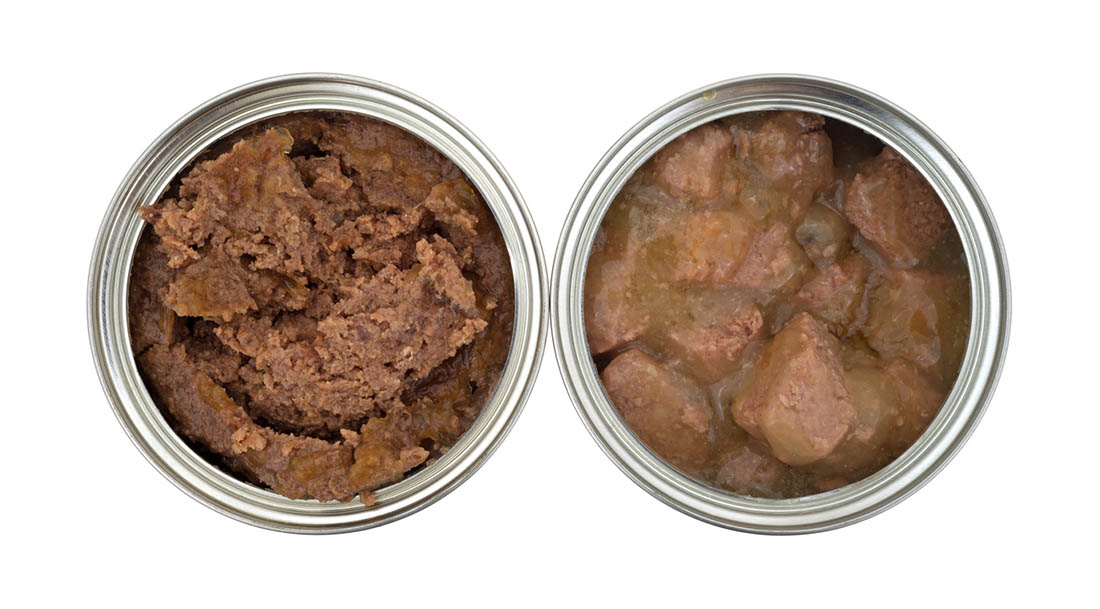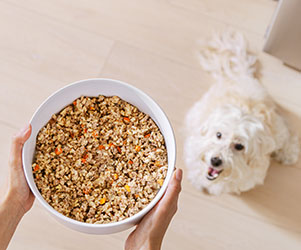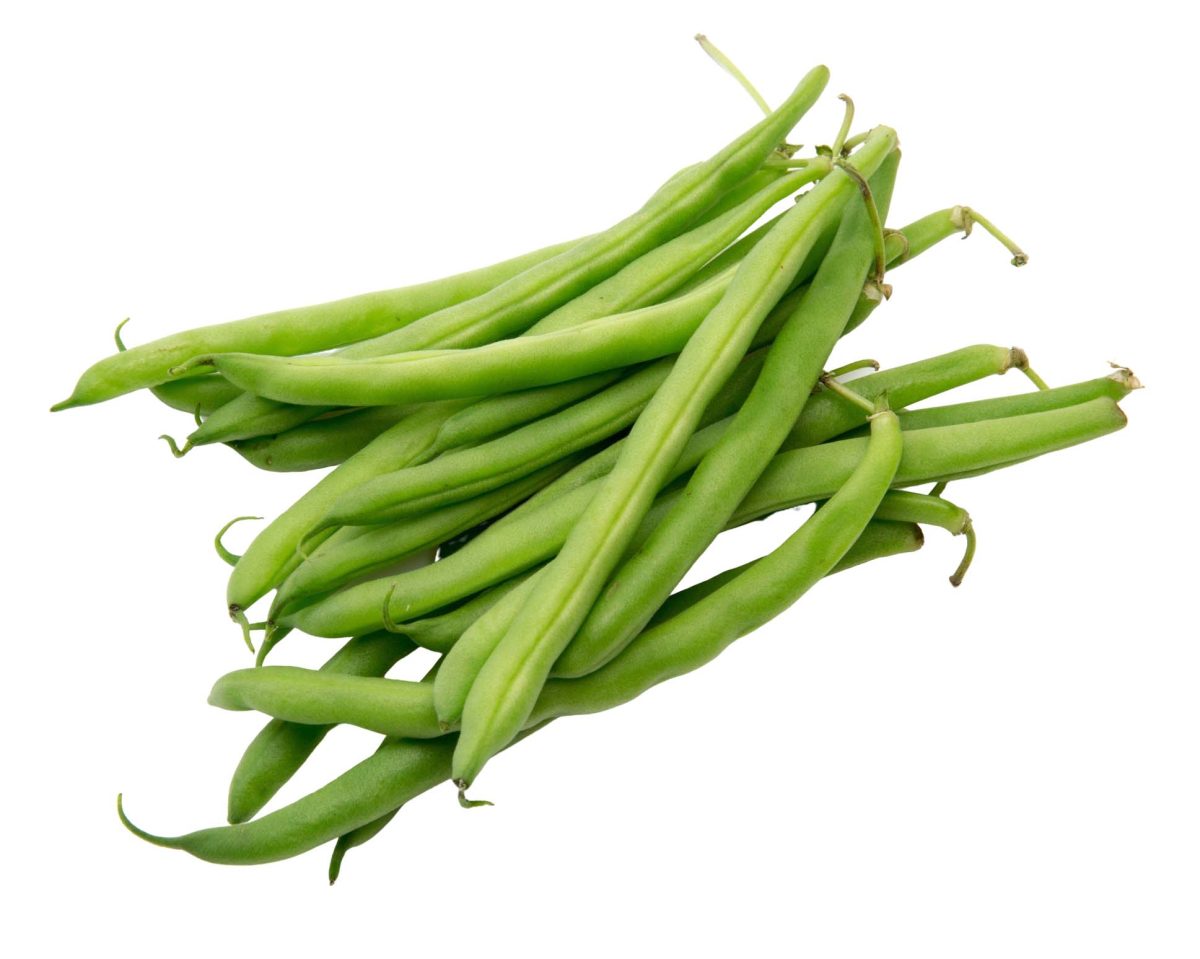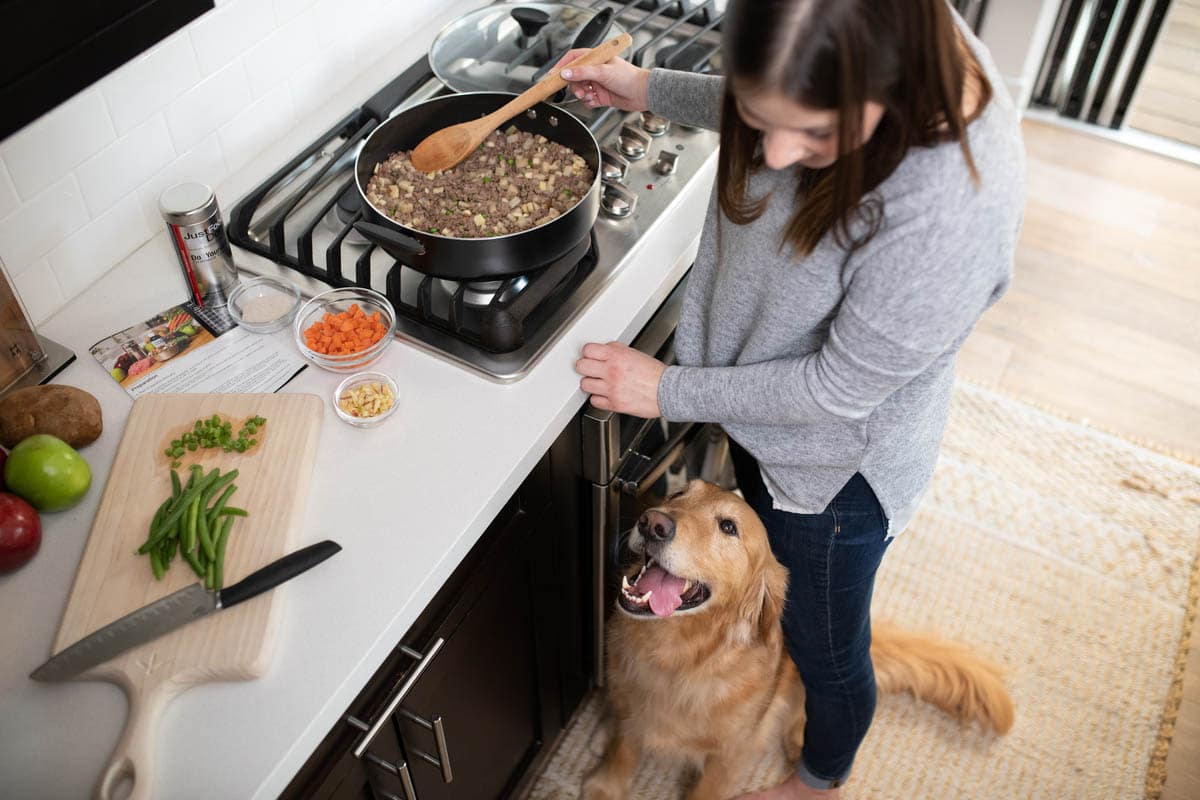Is Wet Dog Food Good for Dogs?
Weighing pros and cons of wet dog food in a can. Are the ingredients in wet dog food good for dogs?
You know the look — those sad eyes looking up at you when you fill your best furry friend’s bowl with kibble. His eyes tell you that he would prefer something more palatable. Will wet dog food help? Is canned dog food good for dogs, though? Does it include everything your dog needs to stay healthy long-term?
Read on to learn more about the history of dog food and its evolution to the wet variety.
When Did People Start Feeding Their Pooch Actual Dog Food?

Dogs were domesticated approximately 16,000 years ago. It was the Industrial Revolution and the subsequent creation of the middle class in the 19th century that led to dogs becoming companion animals.
Dogs started as camp followers who scavenged food from human groups. People noticed and encouraged them because they would alert them to anything approaching. Then, of course, they became a part of the family, as it were.
Humans had already considered what to feed animals by 4,000 years ago, but the recommendation for dogs was simply to feed them meat, bones, and barley soaked in milk. It comes as no surprise that this advice is outdated, to say the least.
Even so, most people simply fed dogs leftovers from the human dinner table until the mid-1800s, when people purchased food specifically for their dogs and cats, at least in the cities.
James Spratt introduced kibble in England around 1860, but it was used mainly by English country gentlemen with hunting dogs. By 1890, kibble came to US markets and more companies started developing their own recipes.
The first canned dog food, made with horse meat, was introduced in 1922 and was known as “Ken-L-Ration.” Of course, our understanding of canine nutrition has changed through the years, and the recipes have changed over time as well.
Today, most dog food brands offer some kind of wet dog food as part of a diet that may meet your dog’s nutritional needs. But is it good or better than the alternatives? Here are the pros and cons.
Wet Dog Food or Dry Dog Food: Which Is Better?
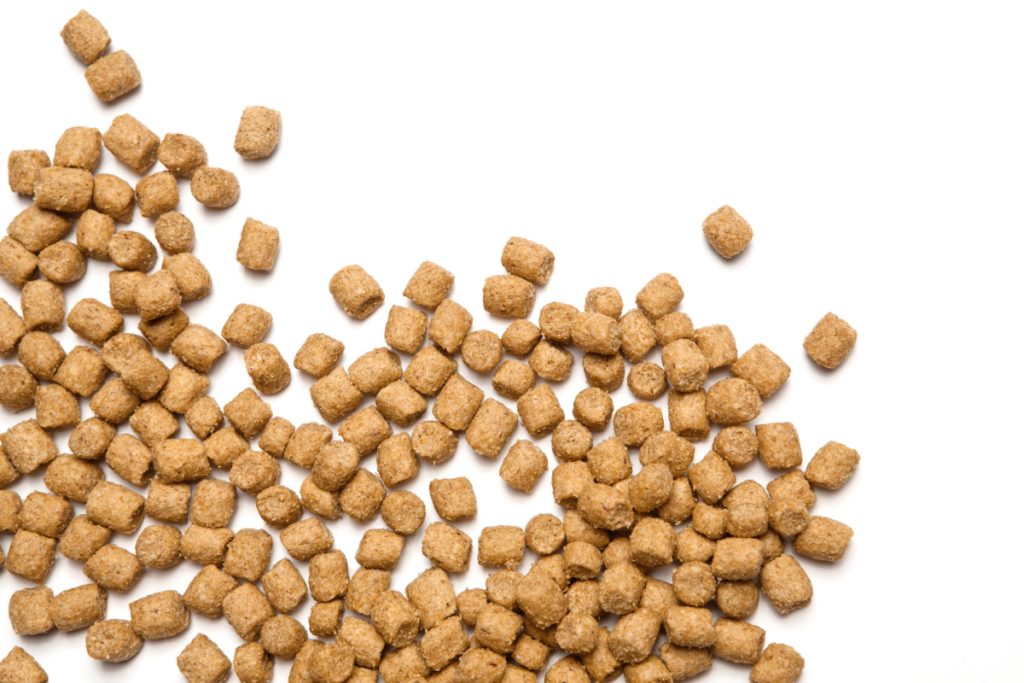
When loving pet parents choose which type of food to feed their pooch, it can quickly become confusing. You already have to make several choices, and wet versus dry dog food is just one more.
Most pet owners will decide on cat food or dog food based on what they have done in the past. When making that choice for a beloved family member, however, you should ensure they get high-quality meals that are both nutritious and delicious.
To help you out with that decision, let’s take a look at the pros and cons of each type of food.
The Pros of Wet Pet Food
There are some benefits to canned dog food or the kind that comes in pouches. Here are a few of them.
Taste
There are actually numerous benefits to wet pet foods, perhaps the biggest one is that pets seem to like the taste better. This might be due to the fact that it smells more strongly, but it could also be that it tastes stronger as well. Additionally, the palatability of the food encourages those picky eaters to eat at mealtime.
Softness
Wet food is chewy and softer than kibble, and that may make a difference with respect to your dog’s ability to eat it. Older dogs with fewer teeth may have an easier time eating canned food as compared to dry food. That translates into health benefits when you consider that a dog who is missing teeth may not eat as much or even at all at times.
Easier to Administer Medications
If you’ve ever had to give your dog oral medication or even something like a supplement, such as a probiotic, you know it can be tricky. But, in the case of canned dog food, it’s much easier to slip a pill into the food, and your dog will likely gulp it down without ever even knowing it was there.
Helps with Hydration
Wet dog food is also higher in water content, which means it can help your buddy stay adequately hydrated. While there is not enough water in the wet food to replace his water bowl, it helps add to what he’s getting from other sources. This higher moisture content is even more important for active dogs and senior dogs for better health and wellness.
More Similar to Natural Diets
From a nutritional standpoint, there are few differences between wet and dry food with respect to protein and fat content. However, there is a significant difference when it comes to carbohydrates. Dry dog food has a much higher carbohydrate content than wet dog food.
Researchers looking into the palatability of cat food suggest that cats might prefer wet foods because they can more strongly taste the amino acids that make the food more similar to their natural diets. The same may be true for dogs. The ability to taste the amino acids more strongly is related to the lower carbohydrate content in wet pet food.
The Cons of Feeding Wet Pet Food
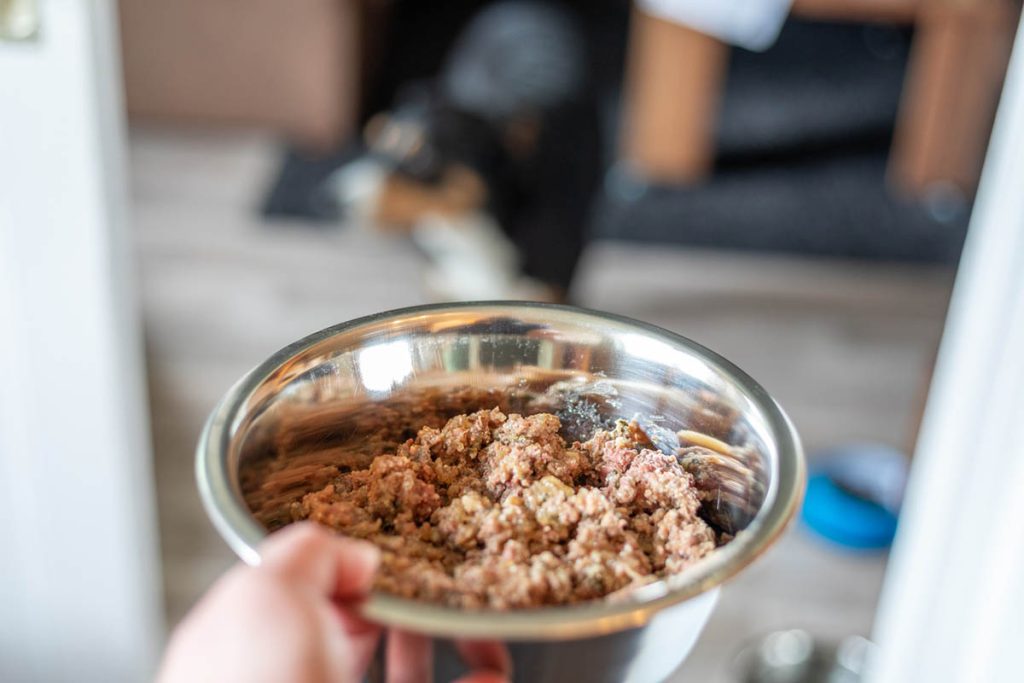
While there are some positive aspects of feeding wet pet food, there are drawbacks.
Dental Health
Because wet food is soft, it doesn’t help chip away at the tartar buildup on your dog’s teeth in the same way that kibble might. However it’s important to know that even kibble doesn’t do the job well. It might help with scraping tartar off teeth, but not where it really counts–the gumline.
Canned Food Doesn’t Keep
Because of the way dry food is made and packaged and the preservatives it contains, it has a very long shelf-life. Canned food, once opened, requires refrigeration, and even then, it doesn’t last very long.
The Carrageenan Factor
Carrageenan is a plant-based product of Irish moss, an edible seaweed. It is an additive that helps loaf-like wet pet food hold its shape.
Test results of food-grade carrageenan carried at least 5 percent degraded carrageenan. Degraded carrageenan is a known carcinogen. It’s even used to induce inflammation in animal studies.
Researchers found that it can trigger your dog’s body to produce a molecule called Tumor Necrosis Factor-alpha, or TNF-⍺. This molecule stimulates inflammations and causes cell death, which promotes cancer.
Researchers have also found that your dog’s digestive process can convert carrageenans to dangerous poligeenan. Poligeenan can then cause problems related to chronic inflammation, like irritable bowel disease (IBD), for both dogs and cats. This type of additive is used in wet dog food but is not usually added to dry food.
Increased Palatability and Obesity
For overweight animals, the increased palatability of wet dog food could make them eat more. This could increase any problems related to obesity and associated health issues like diabetes as well.
Less Convenience
Any leftovers go in the fridge. If the dog doesn’t eat it in a timely manner, you have to throw it out. That makes them more wasteful and costly.
Finally, because wet dog food doesn’t have the preservatives found in dry dog food, it can more easily go rancid. Don’t leave any wet food in your dog’s bowl to gather bacteria and wash his bowl after every feeding.
Pros of Feeding Dry Dog Food
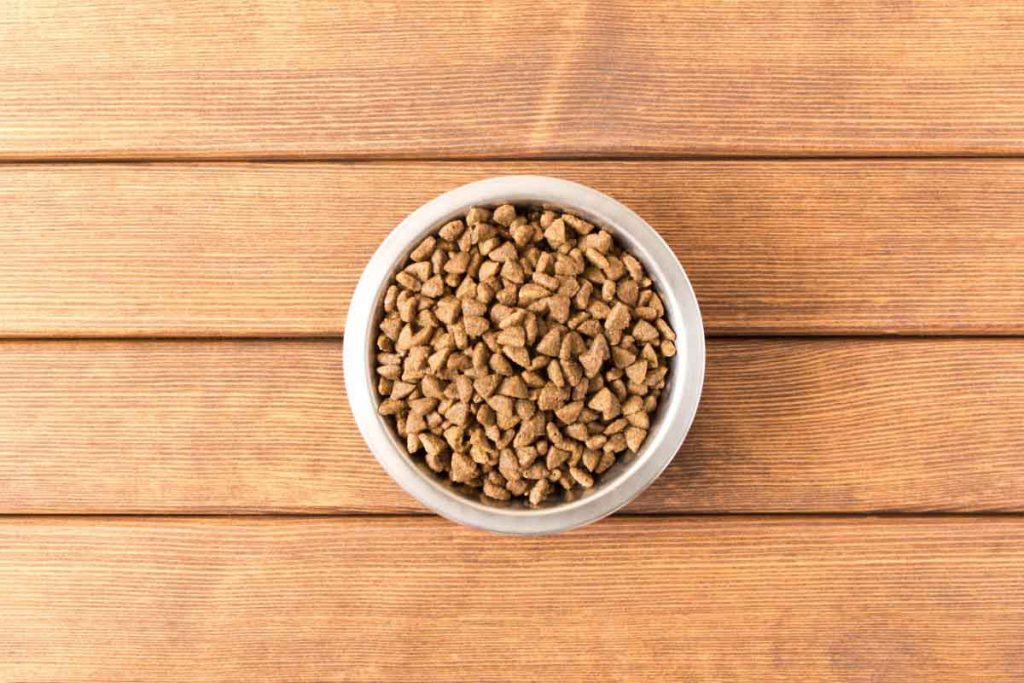
Purina was the first company to produce dry dog and cat kibble in the late 1950s and early 1960s. It was seen as a boon to the pet food industry, so let’s take a look at the pros of feeding dry food to your furry friend.
Long Shelf-Life
This is arguably the biggest benefit of using dry food in your dog’s diet. It does not spoil rapidly. That means kibble can be bought in bulk, and it is less expensive per calorie to feed.
Easy Storage
Dry kibble has a lower volume and weight than canned dog food, which makes it easier to store. Additionally, refrigeration is not required after opening. Both of those factors make it more convenient for dog owners than canned food.
Mental Enrichment Opportunities
Another benefit of dry kibble is that it can be combined with gadgets, like bowl feeders designed for playing and slowing down how rapidly your dog eats. These bowls often have you hide the kibble in a space where your dog has to try to find it or do something to get it out. Of course, wet dog food would not work for this purpose very well. These devices can offer mental stimulation for your dog, making for a happier life.
Cons of Dry Dog Food
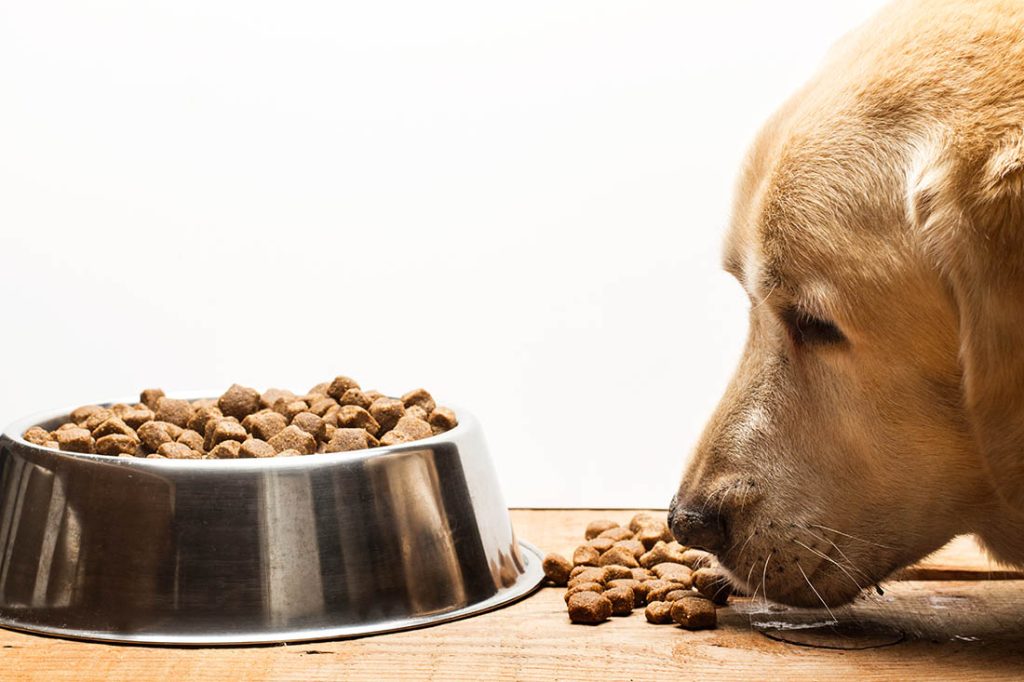
As with canned dog food, there are some drawbacks to feeding dry dog food. Here are a few for your consideration.
Picky Eaters
If you’ve got a picky eater on your hand, it can be difficult to get them to eat kibble. Studies do show that both adult dogs and cats like to mix it up from time to time when it comes to their food. Just like with humans, they want some variety, so just feeding kibble all the time gets boring.
Buy in Bulk for Better Price
Feeding dry dog food can be more cost-effective if you can buy it in bulk and if your dog will eat it all before growing tired of it. But some people can’t afford to buy in bulk, they can’t lift the bag, or they don’t have a place to store it. In that case, you’re not getting a much better price than what you get when you feed canned food. In fact, you may pay more per gram for a smaller bag of kibble than for canned dog food.
Quality Ingredients
Finally, there is the question of the quality of the ingredients in dry kibble. While the percentages do meet the requirements for pet food, manufacturers may be using lower-quality food products (“feed grade”), like fillers and meat by-products like chicken beaks.
What About Whole, Fresh Food?
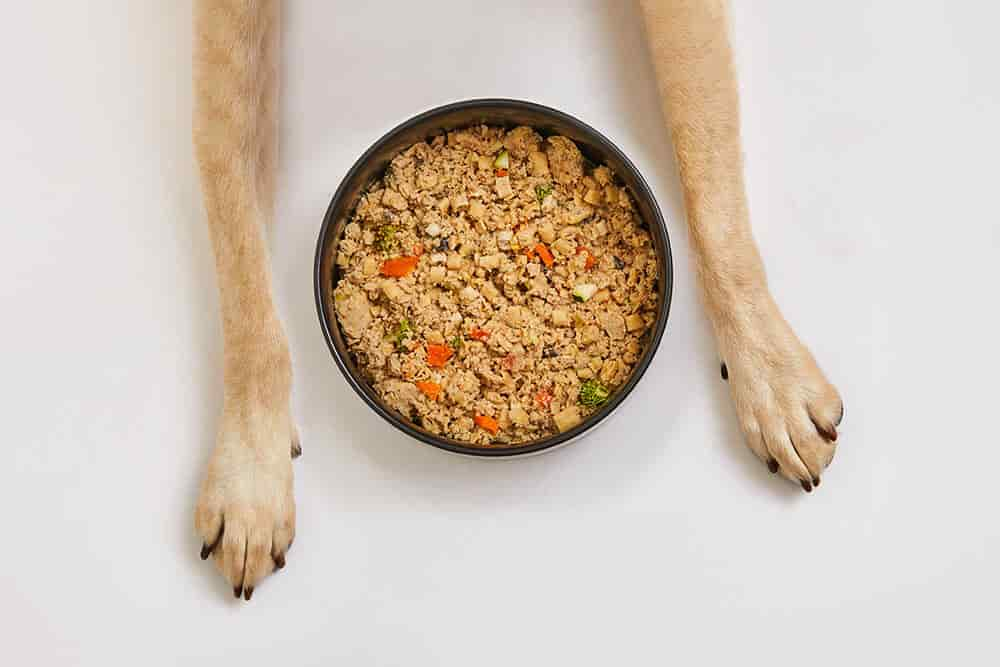
There is another choice for what to feed your dog. While there is no industry standard definition, whole, fresh dog food typically refers to dog foods that have the following characteristics:
- Human Grade Nutrition: Made from USDA ingredients safe for human consumption. That also means that they are manufactured and packaged per federal regulations.
- Whole Foods: These are the same kinds of foods that you would feed yourself, including vegetables, grains, and meats.
- High-Quality Ingredients: You won’t find any chicken beaks or feet in this kind of dog food. Instead, the manufacturers of whole, fresh dog food don’t use any unnecessary by-products. They use the same kinds of meats found in human foods you get in restaurants and grocers.
- Gently Cooked: Fresh dog food is cooked at lower temperatures, which aids in reducing the breakdown of nutrients like proteins, vitamins, and carbohydrates. These dog foods tend to be more nutrient-dense and digestible as a result.
- No Preservatives or Other Additives: Fresh dog food does not contain preservatives or other additives.
Fresh Dog Food
What are the benefits of feeding fresh dog food as compared to kibble or even canned dog food?
- More Nutritional: Whole, fresh dog food is higher in moisture and nutrients than other types of dog food. This is because it is cooked at lower temperatures.
- More Digestible: One study showed that fresh dog food was 40% more digestible than kibble because the moisture aids in breaking down the food, and that makes it easier for your dog to absorb those nutrients.
- Tastes Better: Fresh food is also more appealing to your best friend than highly processed foods like kibble and most canned dog foods. If it’s tastier, your picky eater is much more likely to eat it up!
- Allergies: Because fresh food is more limited in the number of ingredients, it reduces the risk of allergies in dogs. If your dog does have an allergic reaction, the fewer ingredients will make it easier for you and your veterinarian to identify what is causing the problem.
- Smaller, Fewer Poops: A study published in the Journal of Animal Science found that dogs who were fed a fresh whole-food diet were able to absorb more nutrients and subsequently produced up to 66% fewer stools as compared to a premium-grade kibble diet. They also found that dogs fed human-grade fresh whole-food diets produced 41% fewer poops than those dogs fed a feed-grade, fresh processed brand.
Citations
Do, Sungho, Thunyaporn Phungviwatnikul, Maria R C de Godoy, and Kelly S Swanson. 2021. “Nutrient Digestibility and Fecal Characteristics, Microbiota, and Metabolites in Dogs Fed Human-Grade Foods.” Journal of Animal Science 99 (2). https://doi.org/10.1093/jas/skab028.
Oba, Patrícia M, Pamela L Utterback, Carl M Parsons, and Kelly S Swanson. 2019. “True Nutrient and Amino Acid Digestibility of Dog Foods Made with Human-Grade Ingredients Using the Precision-Fed Cecectomized Rooster Assay1.” Translational Animal Science 4 (1): 442–51. https://doi.org/10.1093/tas/txz175.
Wang, Guo-Dong, Weiwei Zhai, He-Chuan Yang, Lu Wang, Li Zhong, Yan-Hu Liu, Ruo-Xi Fan, et al. 2015. “Out of Southern East Asia: The Natural History of Domestic Dogs across the World.” Cell Research 26 (1): 21–33. https://doi.org/10.1038/cr.2015.147.
Watson, Tim. 2011. “Palatability: Feline Food Preferences.” Vet Times. 2011. https://www.vettimes.co.uk/article/palatability-feline-food-preferences/.
Bhattacharyya, Sumit, Pradeep K. Dudeja, and Joanne K. Tobacman. 2010. “Tumor Necrosis Factor α-Induced Inflammation Is Increased but Apoptosis Is Inhibited by Common Food Additive Carrageenan.” Journal of Biological Chemistry 285 (50): 39511–22. https://doi.org/10.1074/jbc.m110.159681.
Bhattacharyya, Sumit, Haiying Liu, Zhenqing Zhang, Murielle Jam, Pradeep K Dudeja, Gurvan Michel, Robert J Linhardt, and Joanne K Tobacman. 2010. “Carrageenan-Induced Innate Immune Response Is Modified by Enzymes That Hydrolyze Distinct Galactosidic Bonds.” Journal of Nutritional Biochemistry 21 (10): 906–13. https://doi.org/10.1016/j.jnutbio.2009.07.002.
Rofe, P. C., and R. S. Anderson. 1970. “Food Preference in Domestic Pets.” Proceedings of the Nutrition Society 29 (2): 330–35. https://doi.org/10.1079/pns19700064.
This content is for informational use only and does not replace professional nutrition and/or medical advice, diagnosis, or treatment. It is not a substitute for specific nutrition and/or medical recommendations. Please talk with your veterinarian about any questions or concerns.
